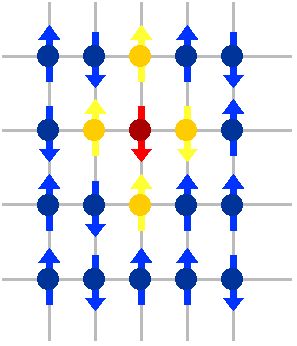Ising model
An Ising model is a simple model used in statistical mechanics.
The Ising model imitate behavior in which individual elements (e.g., atoms, animals, protein folds, biological membrane, social behavior, etc.) modify their behavior so as to conform to the behavior of other individuals in their vicinity.
Mathematics
The energy is given by
The total energy (the antiferromagnetic Hamiltonian) is given by Failed to parse (syntax error): {\displaystyle H = \frac{J}{2} \sum_{<ij>} S_i S_j -− h\sum_i S_i }
where
- <i,j> symbolize all pairs of nearest neighbors on the lattice
- J measures the strength of the spin-spin interaction energy.
- If it's positive (ferromagnetic), the energy is lowered when adjacent spins align.
- If it's negative (antiferromagnetic), the energy is lowered when adjacent spins alternate.
- h is a constant (with units of energy such as joules, ergs, etc) indicating any other interactions of individual spins with some external magnetic field
Magnetization
Magnetization is simply the mean of all spins
Brief History
(1920) The Ising model was proposed in the 1924 doctoral thesis of Ernst Ising when he tried to explain certain empirically observed facts about ferromagnetic materials using a model proposed by his instructor, Lenz.
(1928) Heisenberg referred to it in his paper, which used the exchange mechanism to describe ferromagnetism.
(1936) Peierls publishes a paper, which gave a non-rigorous proof that spontaneous magnetization must exist, that allowed the name "Ising model" to become well-established.
(1941) A breakthrough occurred: it was shown that a matrix formulation of the model allows the partition function to be related to the largest eigenvalue of the matrix. Kramers and Wannier calculated the Curie temperature using a two-dimensional Ising model.
(1944) A complete analytic solution was given by Onsager.
Applications
Recent
The Ising model has more recently been used to model phase separation in binary alloys and spin glasses.
Biology
The Ising model represents neural networks, flocking birds, or beating heart cells.
Sociology
Religion and peer pressure are very good examples of this

